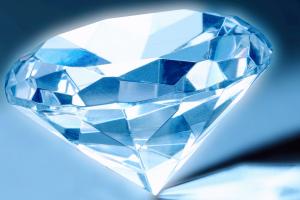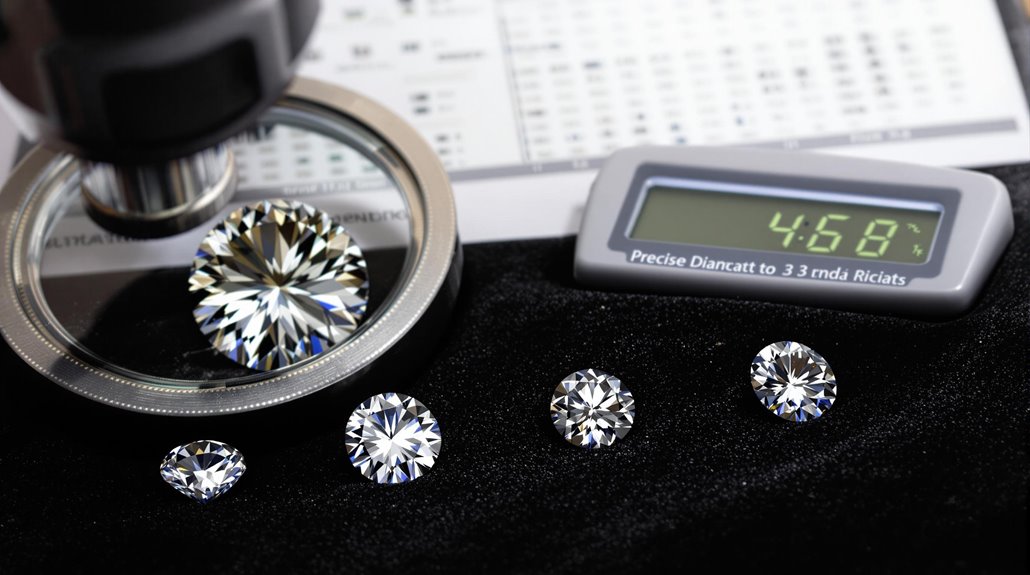Article Contents
- 1 Frequently Asked Questions
- 1.1 How Do Lab-Grown Diamonds Compare in Price to Natural Mined Diamonds?
- 1.2 Can I Negotiate the Price of a Diamond at a Retail Store?
- 1.3 Why Do Similar-Looking Diamonds Have Vastly Different Prices?
- 1.4 Do Diamond Prices Typically Appreciate or Depreciate Over Time?
- 1.5 What Documentation Should I Request When Purchasing an Expensive Diamond?
Diamond pricing reflects the intricate interplay of five crucial elements: carat weight, shape, cut quality, clarity, and color grades. Carat weight serves as the primary value driver, with larger stones commanding exponentially higher prices because of their rarity. The round brilliant cut, featuring 57 facets, remains the most sought-after shape, whereas SI1-VS2 clarity and F-H color grades represent optimal quality standards. Comprehending these factors, along with current market dynamics, unlocks the secrets of diamond valuation.
The intricate world of diamond pricing represents a complex interplay of factors that determine a stone's ultimate value in the market. At the vanguard of these considerations stands carat weight, which serves as the primary driver of a diamond's worth owing to the inherent rarity of larger stones. For example, a 2.00 to 2.50 carat natural diamond typically costs between $20,000 to $35,000. As market demand fluctuates, the relationship between size and value becomes increasingly pronounced, with larger diamonds commanding exponentially higher prices per carat, reflecting their scarcity in nature. A standard price per carat calculation helps determine the final cost of diamonds at any size.
The diamond's shape plays a vital role in its valuation, with round brilliant cuts maintaining their position as the most sought-after and valuable choice. This preference stems from their superior light performance and traditional appeal, though elaborate shapes offer compelling substitutes at more modest price points. The professional guidance from experienced jewelers is crucial when selecting the optimal shape for both value and aesthetics.
The quality of a diamond's cut proves equally significant, as it directly influences the stone's ability to capture and return light, creating the captivating sparkle that connoisseurs prize. The round brilliant cut features 57 facets designed to maximize light reflection and brilliance.
Clarity and color grades form another fundamental component of diamond valuation, with stones in the SI1-VS2 clarity range and F-H color grades representing an optimal balance of quality and value. These characteristics, when validated by prestigious certification bodies like the Gemological Institute of America (GIA) or the American Gem Society (AGS), provide assurance of a diamond's quality and contribute significantly to its market value.
The pricing mechanism itself operates on a sophisticated system that considers multiple variables simultaneously. The baseline "rap price" serves as a reference point, though actual transaction prices may vary based on market conditions and individual stone characteristics.
This pricing structure becomes more complex as diamonds cross certain weight thresholds, with even minimal differences in carat weight potentially resulting in substantial price variations.
The distinction between natural and laboratory-grown diamonds represents a significant pricing consideration in today's market. Although sharing identical physical and chemical properties, natural diamonds command premium prices because of their geological rarity and traditional appeal.
This pricing divergence reflects both the technological advances in diamond creation and the enduring value placed on naturally formed stones.
The impact of certification on diamond pricing cannot be overstated, as these independent assessments provide significant documentation of a stone's characteristics. GIA and AGS certifications, in particular, serve as industry standards, offering detailed analyses of a diamond's quality parameters and contributing to its overall market value.
This systematic evaluation guarantees that each stone's unique combination of characteristics is accurately reflected in its price, providing transparency and confidence to discerning buyers in the luxury diamond market.
Frequently Asked Questions
How Do Lab-Grown Diamonds Compare in Price to Natural Mined Diamonds?
In today's insanely competitive market, lab-grown diamonds cost significantly less – typically 50-70% cheaper than mined diamonds, offering budget-friendly benefits as well as avoiding traditional mining's hefty price tags and environmental drawbacks.
Can I Negotiate the Price of a Diamond at a Retail Store?
Most independent jewelers allow retail negotiation on diamond pricing, with potential discounts of 30-40%. Chain stores typically offer less flexibility, though polite negotiation is commonly acceptable in the industry.
Why Do Similar-Looking Diamonds Have Vastly Different Prices?
Similar-looking diamonds vary in price because of subtle differences in cut quality and color grading that affect brilliance and value, even when these distinctions aren't immediately visible to untrained eyes.
Do Diamond Prices Typically Appreciate or Depreciate Over Time?
Diamond prices typically appreciate over time, following long-term market trends, though investment potential varies. Natural diamonds usually maintain value better than other luxury purchases in established markets.
What Documentation Should I Request When Purchasing an Expensive Diamond?
Vital documentation includes a GIA Diamond Grading Report, certification of authenticity, and professional appraisal documentation. These verify the diamond's characteristics, legitimacy, and value for insurance purposes.

